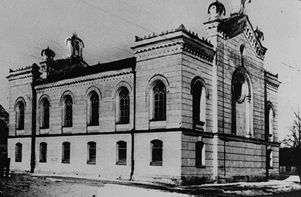
Symposium Kuldiga introduction
latvian press release: relize and as pdf After the independence of Latvia, a discussion started about the joint guilt of Latvians in the extermination of Jews. Again and again the discussion was instigated by Jewish historians such as Margers Vestermanis. There is conspicuous defence for this controversial dispute in Latvian Society, showing historical parallels to German society's denial of blame in the years after 1945. The discussions centered on Auschwitz as a crime against mankind, only started in the late seventies. Latvian society, however, now receives a great deal more international pressure. As a result of this pressure, at last, a special state commission has been set up to deal with the question of how to create a suitable memorial of Auschwitz. In contrast to Germany, in many Latvian towns the synagogue buildings still exist. They are owned by the communities. In Sabile were discussions started about how to handle their synagogue buildings. The result is that it is no longer used as a gymnasium, but after an extensive renovation, as a communal Jewish museum. In Riga remains the only Jewish community nowadays still using their synagogue. In the rest of the country the synagogues just remain as ruins or have different uses. A public debate about how these places should be used as landmarks of the memory, has not begun yet. Right now, there is no indication that in Latvian towns, Jewish communities will appear again. A discussion about ways of keeping and shaping the memory cannot exclude the possibility of Jewish life in Latvian towns in a future. In Kuldiga the synagogue building was used as a cinema up to the middle of the Nineties. When it was shut down, plans followed to set up a nightclub. The May family heard this and started a petition around Riga's art scene, suggesting a transformation of the building into a concert hall. Leo May was born in Kuldiga and survived Auschwitz. In summer 2006 sociologist Mike Hartwig met with art historian and landscape architect Agnese Kusmane from the town council of Kuldiga. Since then there has been a debate over how the synagogue building could become place of memory, a place to memorialize the murdered Jews of Kuldiga. Since autumn 2006, historian and publicist Jens Hoffmann and the architect and curator Sven Eggers joined in the discussion. In the beginning of september 2007 the symposium and an interdisciplinary workshop takes place in Kuldiga with the support of Jewish Coucils of Latvia, the Konrad-Adenauer-Stiftung and the muncipality of Kuldiga. The results will be presented to the public in Kuldiga on saturday, the 9th, and later in a publication. The discussions over Kuldiga's synagogue are intended to provide a template for future discussions in other locations. What is the responsibility of a society for it's own actions? Do some forms of memorial do more to burden a society than give a force for reflection? Is it adequate to install a Jewish museum in a place where ‘Jewish life’ occurred? Is the plan to build a concert hall in the former synagogue in Kuldiga, a physical demonstration of Adorno's objective "to do everything to make Auschwitz not happen again"? |